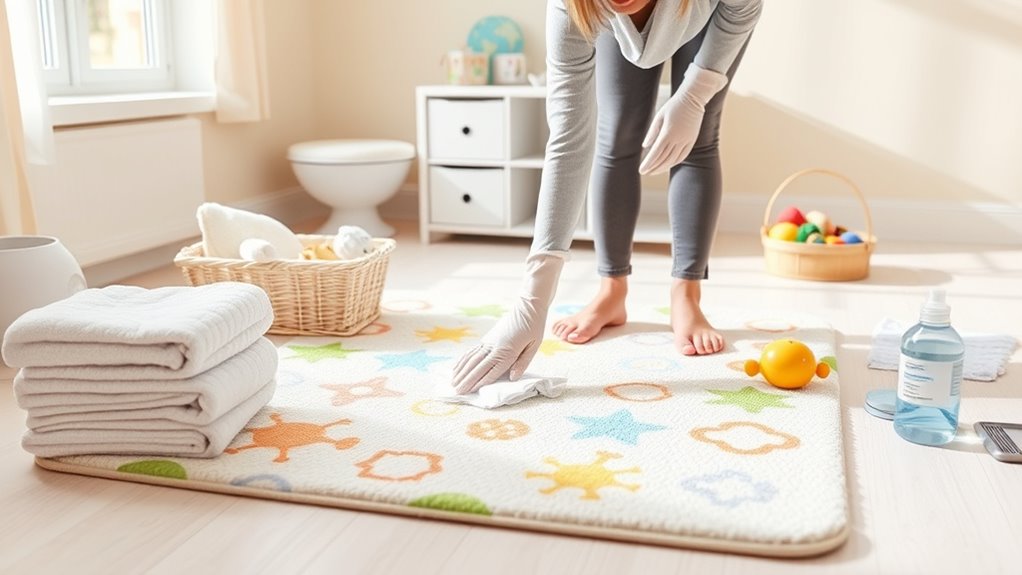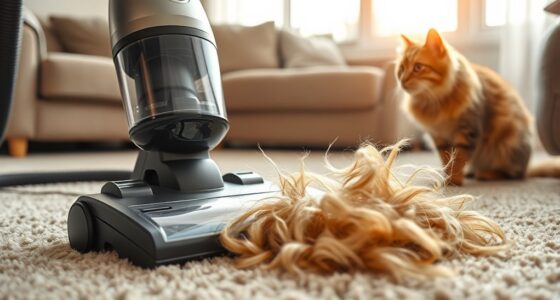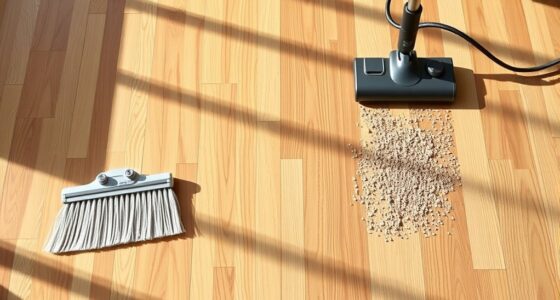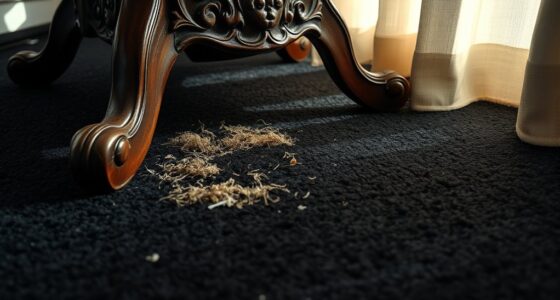To prepare a safe baby crawling zone, clear the area of small objects, sharp edges, and choking hazards, and secure furniture to walls. Keep the space clean by sweeping, vacuuming, and disinfecting high-touch surfaces regularly, while using gentle, baby-safe cleaning solutions. Choose soft, washable mats or rugs that are easy to maintain, and opt for non-toxic, hypoallergenic materials. Maintaining these safety and hygiene practices helps create a secure environment, and with more tips, you’ll feel confident in your baby’s space.
Key Takeaways
- Regularly clean and disinfect floors, rugs, and high-touch surfaces to minimize germs and bacteria buildup.
- Remove small objects, sharp edges, and choking hazards from the crawling zone for safety.
- Use non-toxic, hypoallergenic paints and materials to ensure a healthy environment for your baby.
- Secure furniture and secure electrical outlets to prevent accidents during exploration.
- Maintain a clutter-free, dedicated crawling area and implement routine cleaning to promote hygiene.

Creating a safe and stimulating space for your baby to crawl is vital for their development. As a new parent, you want to ensure that the crawling zone is both inviting and secure, which means paying close attention to safety precautions and cleaning routines. First, consider the layout of the space. Remove any small objects, sharp edges, or items that could pose a choking hazard. Use outlet covers and secure furniture to the wall to prevent tipping. Making sure the area is free from clutter not only creates a safer environment but also encourages your baby to explore freely without unnecessary risks.
Creating a safe, clutter-free space with secured furniture supports your baby’s healthy exploration.
Once you’ve addressed these safety precautions, focus on establishing effective cleaning routines. Babies tend to put everything in their mouths, so keeping the crawling zone clean is vital. Regularly sweep or vacuum the area to remove dirt, crumbs, and dust that can accumulate on the floor. Mop with a gentle, baby-safe cleaning solution at least once a week to eliminate germs and bacteria. Pay special attention to high-touch surfaces like door handles, light switches, and toys, disinfecting them frequently. These routines help minimize exposure to germs that can cause illness and promote a healthier environment for your little one.
Choosing the right flooring also plays a role in maintaining hygiene and safety. Soft, washable rugs or mats provide a cushioned surface for crawling, reducing the risk of injury if your baby falls. Make sure they are easy to clean and free of loose fibers or fringe that could catch tiny fingers or toes. When cleaning these mats, follow manufacturer instructions to avoid any damage, and wash them regularly to prevent dust mites and mold buildup. Additionally, quality flooring materials can contribute to easier maintenance and better hygiene, ensuring a safer space for your baby.
In addition to cleanliness, consider the materials in your baby’s zone. Opt for non-toxic, hypoallergenic paints, flooring, and furniture to reduce the risk of allergic reactions or chemical exposure. Regularly inspect the area for signs of wear or damage, fixing or replacing items as needed to maintain a safe space. Remember, a clean and well-maintained crawling zone not only protects your baby from potential hazards but also encourages healthy exploration. By staying consistent with safety precautions and cleaning routines, you’ll create an environment where your baby can safely develop their motor skills and curiosity, all while giving yourself peace of mind.
Frequently Asked Questions
How Often Should I Disinfect the Crawling Zone?
You should disinfect the crawling zone at least once a day, especially after playtime or when it gets dirty. Stick to a regular cleaning frequency to keep germs at bay and guarantee a safe space for your baby. Use child-safe disinfectants and wipe down surfaces thoroughly. Maintaining a consistent disinfecting schedule helps prevent bacteria buildup and creates a hygienic environment, giving you peace of mind as your little one explores.
Are There Non-Toxic Cleaning Options?
Non-toxic cleaning options like natural cleaning products and chemical alternatives can keep your baby safe while battling germs. Think about using vinegar, baking soda, or plant-based cleaners—they’re powerful enough to disinfect without exposing your little one to harsh chemicals. These natural cleaning methods are gentle, effective, and perfect for creating a safe, healthy crawling zone that’s free of toxic residues.
Should I Use Baby-Proof Rugs or Mats?
You should definitely use baby-proof rugs or non-slip mats in your crawling zone. These help prevent slips and falls, keeping your little one safe as they explore. Look for baby-proof rugs with non-slip backing or add non-slip mats underneath to enhance stability. This way, your baby can crawl comfortably without the risk of slipping, and you can enjoy peace of mind knowing the area is both safe and hygienic.
How Do I Keep Pests Away From the Crawling Area?
You can keep pests away from your baby’s crawling area by implementing pest prevention strategies. Think of pest deterrents like natural repellents, such as essential oils or citronella, that create a barrier they avoid. Regularly clean the space, seal cracks, and remove food sources to make the environment less attractive. These steps help create a safe, pest-free zone, giving you peace of mind as your little one explores.
Can I Use Essential Oils Safely in the Zone?
You can use essential oils safely in your baby’s crawling zone if you follow essential oil safety guidelines. Dilute oils properly and avoid direct contact with your baby’s skin. Instead of harsh chemicals, consider natural disinfectants like vinegar or tea tree oil, but always research their safety for babies. Keep oils out of reach and ensure good ventilation. This way, you create a safe, naturally disinfected environment for your little crawler.
Conclusion
By creating a safe, clean crawling zone, you’re laying the foundation for your baby’s exploration and growth. Think of it as building a little kingdom where curiosity can roam freely without worry. Keep the area tidy, regularly sanitize, and choose non-toxic materials. With these simple steps, you’ll turn your home into a nurturing playground—where your little explorer can flourish, safe and sound, like a butterfly emerging from its cocoon.








